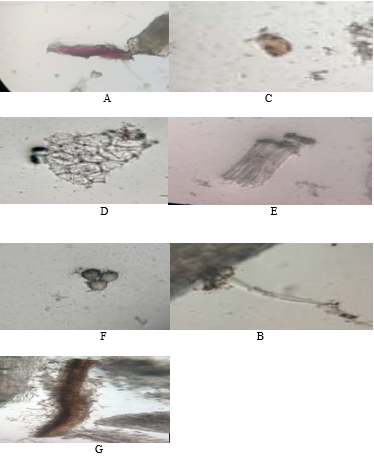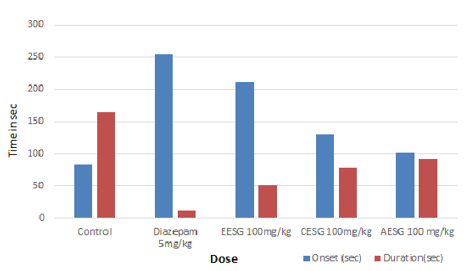Introduction
Herbal medicinal plants used as a traditional medicine by humans from ancient civilization. Now a day’s most of the world population depends on herbal medicines or used mostly herbal medicines for treatment of various diseases. The whole plant as well as different parts of plant used as therapeutic agent in different systems of medicine. Sesbania grandiflora plant having a therapeutic medicinal value which used whole or different part as a medicine in different dosage forms.1
Dosage forms of plant which directly or indirectly effective on human and animals for that effectiveness of medicinal plant standardization procedure is mostly used. Standardization is required because many of people used various dosage forms to treat different types of diseases for better potency of dosage forms mainly depends on quality of raw materials which used to formulate dosage forms. In various medicinal plants contains various activephytochemical which may be toxic in nature so the standardization required in order to decrease the incidence of toxicity and to increase the quality, potency and effectiveness of herbal drugs.2, 3
Sesbania grandiflora having two flower species that is white flowers and purple flowersin that white flower’s species found nontoxic in nature and the purple flowers species is highly toxic in nature.4 Sesbania plant which including in family fabaceae. The plant iscommonly known as a Sesban, agate etc. In the world it is located in India, East Asia, Malaysia, and Indonesia. The height of tree is about 1-4 m tall and short lived with quick growing. The plant having different vernacular names like Sesban, hadge, agate,gallo,picoetc.5, 6, 7 In Sesbania grandiflora plant contains many phytochemical like Alkaloids, saponines, carbohydrates, flavanoids, steroids, triterpens, tannins, phenolic compounds etc.8, 9 As per literature the phytochemicals present in flower part of plant are mainly cyaniding, delphinidine, glucoside, tannins, keampferol, proteins, oleanolic acid, grandiflora etc.10 There is no or less report present for standardization so that qualitative standardization of flower of Sesbania grandiflora was estimated as per standard guidelines. As per literature study several pharmacological activities reported for the flowers of sesbania grandiflora. Sesbania grandiflora is a traditional medicinal plant used for treatment of various disorders including seizures. The Sesbania grandiflora flowers has not been studied in depth for its anticonvulsant activity. In below study we have evaluated anticonvulsant activity on flowers of sesbania grandiflora.11
Materials and Methods
Chemical and reagents
The standard drugs and chemicals wereobtained from pravara rural college of pharmacy Pravaranagar, Loni, were having analytical grades and highest purity.
Collection and authentication of plant materials
The white flower of Sesbania grandiflora was collected from local areas of Loni, Ahmednagar district, Maharashtra, India.The authentication done by Dr. A.S. Wable, Asst. Professor and research guide, Dept. of Botany of research center PadmashriVikhe Patil College, Loni, India, after that the plant was preserved in herbarium for reference. Ref No: PVPC/Bot/2020-21/HD 1B. Dated-1st December 2020.
Preparation of powder
The freshly collected white glowers of Sesbania grandiflora were shade dried at room temperature 25º for about 15-20 days. Then powdered the flowers and used for further extraction procedure.
Preparation of extract
200 gm powder drug extracted with 800 mi of two solvent separately by using continuous extraction method by Soxhlet apparatus until they became colorless. In that 100-gm powder extracted with 800 ml of ethanol and 100 gm extracted with 800 ml of chloroform. Another 100-gm macerated with aqueous solvent (water). The obtained extract was filtered separately and concentrated. The extract was freeze dried and was used for assessment of phytochemical parameters.
Pharmacognostical Evaluation
Macroscopic study
Macroscopic study includes study of parts of plant that are measurable and seen by naked eye without any help. In macroscopy of Sesbania grandiflora flowers was studied for its color, odor, size, test etc.
Microscopic study12
Microscopic study includes the study of plant object and areas which not seen with the microscope required to study in internal part of plant. In microscopic study, the powder of Sesbania grandiflora flowers was studied for its internal characteristics, like lignified fibers, oil globules, epidermal cells, pollen grains, trichome etc.
Physicochemical evaluation12, 13
The shade dried powder of Sesbania grandiflora was used for determination of different physicochemical constants. The parameters investigated as per standard guidelines of WHO for quality control methods of medicinal plant materials.
Foreign matters
For determination of foreignmatters I used magnifying lanes, sieve to removal of dust and then weighed of foreign matters and determined percentage of it.
LOD
Loss on drying, this parameter used to determine moisture content and volatile substances. The 30 min dried dish must be weighed, then placed powder drug in dish again weighted accurately, placed dish in oven until it get constant weight, allow to cool.
LOD= Initial weight – Final weight from that percentage of loss on drying was determined.
Ash value
It contains total ash, water soluble ash value and acid soluble ash value. The ash value is important to determining the purity and quality of drug.
Total ash value
The weighted powder drug placed in weighted crucible dish and ignites by gradually increasing temperature up to 450º, material became whitish. Ash was weighted and percentage determined.
Water soluble ash value
The total ash obtained was boiled in 25 ml of water for 5 min. After cooled, filtered it by ash less filter paper, washed with hot water and dried the residue and weighted. The difference in weight gave the water soluble ash value.
Acid insoluble ash value
The total ash was added in 25 ml of dil. Hydrochloric acid, heat for 5 min after cooled, filtered it by ash less filter paper and weight with hot water. Dried the residue and weighted accurately. The difference between weights gave the acid soluble ash value.
Extractive value
A weighted amount of plant powder material was taken and then extracted successively with ethanol, chloroform, water. Extract was weighted and determined percentage of extractive value.
Foaming index
Most of the plant contains Saponin that can form foam when shaken with aqueous solution. The1 gm of plant material weighted accurately and added in 100 ml of boiling water for 30 min, cooled and filtered land added on 10 ml of 20 test tubes and shacked. Measured the height of foam and calculated foaming index.
1000/A
A= Volume in ml of test tube which having foam height 1 cm observed.
Phytochemical evaluation12
Preliminary Phytochemical screening is important to determine medicinally active substances which present in plants. Phytochemical study of flowers of Sesbania grandiflora carried out as per standards procedures and guidelines which described by Khandelwal and Mukharjee. Phytochemical investigation carried out for ethanolic extract, chloroform extract and aqueous extract. Different plant extracts contain various phytoconstituents like Alkaloid, phenolic, tannins, flavanoid, Saponin, coumarins, steroids etc. The result was noted and reported in table no- 2
Test for alkaloids
In 2 ml of extract inthat added 0.2ml of alkaloid reagent. At presence of alkaloid Dragendroffs reagent gives reddish brown precipitation and Mayer’s reagent gives white precipitation.
Test for glycoside
In 2 ml extract added 0.2 ml βnapthol and then added few drops of sulphuric acid at presence of glycoside solution shows violet coloration.
Test for steroids
2 ml of extract dissolved with few chloroform and then added equal volume of conc. Sulphuric acid. At presence of steroids chloroform layer show red color and remaining layer shows yellowish green color.
Test for triterpenoids
In 2 ml of extract added chloroform then acetic anhydride and sulphuric acid. At presence of triterpenoids it gives reddish violet color.
Test for tannins
In 2 ml of extract added 0.1 ml lead acetate at presence of tannins formation of white precipitation occurs.
Test for phenols
In 2ml extract added 3 to 4 drops of ferric chloride solution. At presence of phenol it gives bluish black color.
Test for sterols
In 2 ml of extract added 2 drops of acetic anhydride and then added 10 ml of conc. Sulphuric acid at presence of sterols it gives green ring at the junction.
Test for flavanoid
In 2 ml extract added few drops of sodium hydroxide at presence of flavanoid if gives orange color.
Test for saponin
2 ml extract diluted with water and shaken vigorously. At presence of Saponin it forms foam.
Test for naphthoquinone
In 2 ml chloroform extract added 10 % KOH. At presence of naphthoquinone, it gives blue violet coloration.
Anticonvulsant activity study
Wistar Rats will be dividing into five groups. Each group contains of six animals (n=6) and treated for 10 days. The first group will be served as control treating with distilled water and the second group will receive the standard drug Diazepam5mg/kg. The group third will be receiving 100mg/kg ethanolic extract, fourth group will be receiving 100mg/kg aqueous extract, fifth group will be receiving 100mg/kg chloroform extract resp. one’s a day for 10 days, on 10th day 60 min after administration of last dose of extracts convulsions were induced in rats by injection of PTZ 80mg/kg I.P to all the groups. Each animal will be observed individually for convulsive behavior for next 30 min. 14
Statistical Analysis
Statistical analysis data were expressed as standard error of the means (S.E.M) of and statistical analysis was carried out employing one-way ANOVA followed by Dunnett test, which compares the test groups with the control groups.
Results and Discussion
Macroscopic study result
Observed microscopy of flowers of Sesbania grandiflora includes:
Microscopic study result
The characters studied in powder microscopy of flower of Sesbanwere mentioned bellow:
The observed characters were pink colored lignified fibers, Oil globules which stained by Sudan red, epidermal cell, xylem vessels which having spiral thickening, pollen grains, anther filament and covering type of trichome. In flower there was negligible or very less trichomes were present.
Physicochemical parameters study result
The flower part of Sesbania grandiflora was investigated for various physicochemical parameters like moisture content; foreign matter, extractive value, ash value and foaming index etc.The result which observed was shown in Table 1.
Table 1
Physicochemical study of flower of Sesbania grandiflora
Phytochemical screening study result
This was preliminary phytochemical study carried out for different extracts containing various phytoconstituents. The study result reported in table no-2.
Table 2
Phytochemical screening of various extract of flowers of Sesbania grandiflora.
Anticonvulsant Activity
PTZ-pentylenetetrazol method was used for the screening of anticonvulsant activity. The ethanolic extracts, aqueous extract and chloroform extract at dose 100mg/kg significantly at (p<0.01), increases the latency of seizures as well as decrease duration in convulsion. An abolition of seizures was observed with diazepam (5mg/kg). The ethanolic extract (100mg/kg) and chloroform extract (100mg/kg) exhibited protection than Aqueous extract (100mg/kg) against PTZ induced seizure and protection was observed in table no. 3
Table 3
The values are expressed as mean ±SDand the statistical analysis doneby ANOVAby Dennett’s test and value of *p ≤ 0.0, compare to control.
Conclusion
The study of physicochemical parameters is helpful in determination of purity and quality of plant material. The phytochemical parameters may helpful in standardization of plant materials. The result of this study indicates presence of several phytochemical in plant extract, which can be responsible for biological activity. The ethanolic, aqueous and chloroform extract at dose 100mg/kg of Sesbania grandiflora flowers reduces the duration and delay of convulsions in PTZ induced convulsion when compare with control, can be used as therapy against convulsion. For the better efficacy and safety Sesbania grandiflora flowers needed further studies, for its mechanism and active principles responsible for anticonvulsant therapy.This reported study would be helpful to the researchers, students and another who will be working on the flower of Sesbania grandiflora.
Acknowledgement
The authors are thankful to Guide Dr. R.S. Jadhav and Co guide Mrs. Sunayana R Vikhe, Special thanks to Prof. Santosh Dighe, for helped in institutional animal ethics committee and animal studies,all staff members, principal and other helping hands of pravara rural college of pharmacy Loni, for providing facilities and to carry out my work.



